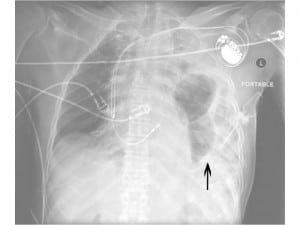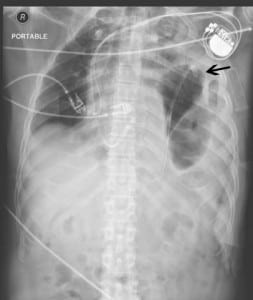| Author | Affiliation |
|---|---|
| Alexander J. Scumpia, DO, MSc | Mount Sinai Medical Center, Department of Emergency Medicine, Miami, Florida |
| Daniel A. Aronovich, DO | Mount Sinai Medical Center, Department of Emergency Medicine, Miami, Florida |
| Loredana Roman, BS | Victor Babes University of Medicine and Pharmacy, Department of Medicine, Timisoara, Romania |
| Vanitha Vasudevan, MD | Ryder Trauma Center, Department of Surgery, Jackson Memorial Health System, Miami, Florida |
| Ryan M. Shadis, MD | Ryder Trauma Center, Department of Surgery, Jackson Memorial Health System, Miami, Florida |
| Mauricio Lynn, MD | Ryder Trauma Center, Department of Surgery, Jackson Memorial Health System, Miami, Florida |
We present a case of a 71-year-old male that was involved in a high-speed motor vehicle collision, as an unrestrained back seat passenger. On primary survey, decreased breath sounds and bowel sounds were auscultated in the left thorax. Secondary survey was positive for left anterior chest wall tenderness. Chest radiograph demonstrated multiple rib fractures, hemothorax, and diaphragmatic rupture with herniation of bowel loops into the chest cavity (Figure 1). Upon insertion of a nasogastric tube, repeat radiograph demonstrated the nasogastric tube to be in the left upper abdomen (Figure 2). The patient underwent emergency laparotomy for repair of his injury. Incidentally, a splenic laceration was identified intraoperatively. Successful repair of the diaphragmatic injury as well as splenectomy was achieved.

Portable anteroposterior chest x-ray demonstrating left rib fractures, hemothorax and left diaphragmatic rupture (arrow). Biventricular pacer is also noted.

Portable anteroposterior chest x-ray demonstrating successful nasogastric tube insertion with tip extending above ruptured diaphragm into thorax (arrow).
DISCUSSION
Diaphragmatic rupture is a relatively rare injury with a reported incidence of 1 to 7% of all patients following significant blunt trauma.1 In a review of 1589 patients, Asensio et al2 reported that 75% had left sided injuries, 23% had right-sided injuries, and 2% had bilateral injuries. This preponderance for left-sided injuries is thought to be related to the protective effect of the bare area of the liver in contact with the diaphragm in the right thorax.3 The pathophysiology in blunt trauma is due to the abrupt change in intraabdomonial pressure that is thought to cause the majority of injuries, although shearing and/or avulsion can also occur especially following lateral trauma.4 The differential includes: pneumothorax, hemothorax, liver injury, bowel injury, rib fractures, splenic injury and kidney injury. Radiographically, the diagnosis is made via chest radiograph demonstrating: nasogastric tube in the chest, herniated loops of bowel within the chest, with or without focal constriction of the viscus.4 The gold standard of treatment is emergent laparotomy.2 The prompt and accurate diagnosis of diaphragmatic rupture is paramount for optimal patient outcome.
Footnotes
Address for Correspondence: Alexander J Scumpia, DO, MSc, Mount Sinai Medical Center, Department of Emergency Medicine, 4300 Alton Rd, Miami Beach, Florida, 33140. Email: ascumpia@yahoo.com.
Supervising Section Editor: Sean Henderson, MD
Submission history: Revision received January 6, 2013; Submitted January 28, 2013; Accepted April 22, 2013
Conflicts of Interest: By the WestJEM article submission agreement, all authors are required to disclose all affiliations, funding sources and financial or management relationships that could be perceived as potential sources of bias. The authors disclosed none.
REFERENCES
1 Scharff JR, Naunheim KS Traumatic diaphragmatic injuries. Thorac Surg Clin. 2007; 17:81-85
2 Asensio JA, Petrone P Diaphragmatic injury. Current Surgical Therapy. 2004; :946-955
3 Sangster G, Ventura V, Carbo A Diaphragmatic rupture: a frequently missed injury in blunt thoracoabdominal trauma patients. Emerg Radiol. 2007; 13:225-230
4 Lochum S, Ludig T, Walter F Imaging of diaphragmatic injury: a diagnostic challenge?. Radiographics. 2002; 22:103-108


